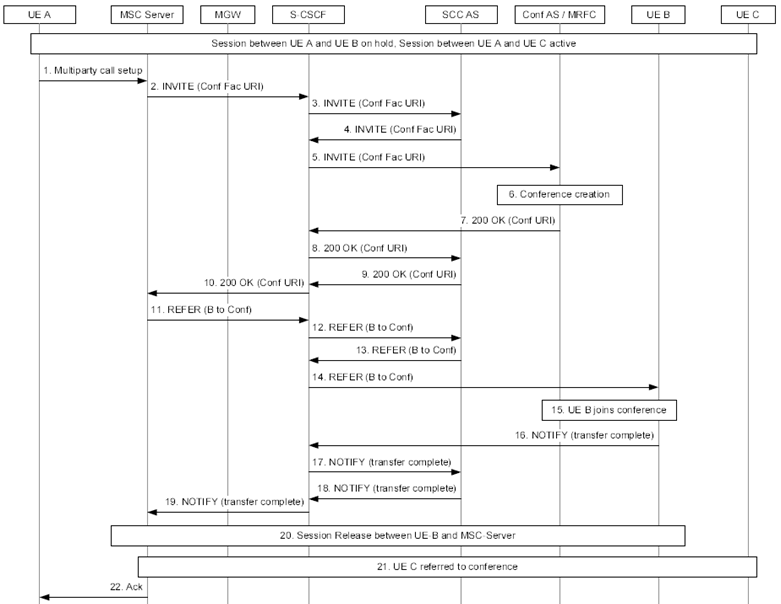Content for TS 23.292 Word version: 18.0.0
1…
4…
5…
7…
7.2…
7.3…
7.3.2.2…
7.3.2.2.4…
7.4…
7.4.2.2…
7.4.2.2.3…
7.4.2.2.7…
7.5…
7.6…
7.6.1.2.2.6…
7.6.1.2.3…
7.6.1.2.3.5…
7.6.1.2.3.6…
7.6.2…
7.6.2.7
7.6.2.8…
7.6.2.11…
7.6.3…
7.7…
7.7.2…
7.9…
7.9.2…
7.9.2.4
7.9.2.5
8…
A…
G…
H…
H.5…
H.5.3…
7.6.2.8 Conferencing
7.6.2.9 User configuration of communication service settings
7.6.2.9.1 TAS procedures
7.6.2.9.2 UE supporting multimedia telephony
7.6.2.9.3 MSC Server enhanced for ICS
7.6.2.10 Customized Alerting Tone (CAT)
...
...
7.6.2.8 Conferencing p. 90
For IMS sessions established by UEs using CS media, the MSC Server enhanced for ICS shall perform the necessary interworking between the I2 reference point and CS signalling (e.g. as described in TS 24.084) to allow Conferencing to be controlled by the IMS.
When the UE initiates three-way session creation via CS access, the MSC Server enhanced for ICS shall support the initiator role as described in TS 23.228 on behalf of the UE. The MSC Server enhanced for ICS shall be able to derive a conference factory URI, e.g. using components from the subscriber's identity (e.g. IMSI).
Once a conference is created, the MSC Server enhanced for ICS shall supporting adding parties to or removing parties from the conference on behalf of the UE.
The MSC Server enhanced for ICS shall also support joining a conference on behalf of the UE upon receiving an invitation from a remote party or conference focus.
If the conference is being managed by a UE using CS media, the MSC Server enhanced for ICS shall not allow the UE to create a private conversation with a remote party by splitting that party from the conference.
The MSC Server enhanced for ICS may subscribe to the conference related events in IMS. And when the MSC server receives the conference related events, it should inform the UE of the events.
Figure 7.6.2.8-1 describes how conference creation can be performed via CS access, with the MSC Server enhanced for ICS playing the role of conference initiator on behalf of the UE. This flow does not preclude the use of other mechanisms for inviting remote parties to the conference as specified in TS 24.147.

Figure 7.6.2.8-1: IMS Conferencing via MSC Server enhanced for ICS (initiator)
(⇒ copy of original 3GPP image)
(⇒ copy of original 3GPP image)
Step 1.
UE A initiates creation of the conference by sending a multiparty call setup message (e.g. Build MPTY message as specified in TS 24.084).
Step 2.
The MSC Server derives a conference factory URI and sends an INVITE to the S-CSCF.
Step 3.
Filter criteria directs the S-CSCF to send the INVITE to the SCC AS.
Step 4.
The SCC AS sends the INVITE to the S-CSCF.
Step 5.
The S-CSCF sends the INVITE to the Conferencing AS / MRFC.
Step 6.
The Conferencing AS / MRFC creates a conference connection as specified in TS 24.147.
Step 7.
The Conferencing AS / MRFC returns the conference URI to the S-CSCF.
Step 8.
The S-CSCF sends the response to the SCC AS.
Step 9.
The SCC AS sends the response to the S-CSCF.
Step 10.
The S-CSCF sends the response to the MSC Server.
Step 11.
The MSC Server sends a REFER to UE B to refer that party to the conference.
Step 12.
The S-CSCF sends the REFER to the SCC AS as it was inserted at session establishment.
Step 13.
The SCC AS sends the REFER to the S-CSCF.
Step 14.
The S-CSCF sends the REFER to UE B.
Step 15.
UE B joins the conference as specified in TS 24.147.
Step 16.
UE B sends a NOTIFY indicating transfer to the conference is complete.
Step 17.
The S-CSCF sends the NOTIFY to the SCC AS.
Step 18.
The SCC AS sends the NOTIFY to the S-CSCF.
Step 19.
The S-CSCF sends the NOTIFY to the MSC Server.
Step 20.
UE B initiates a session release.
Step 21.
Steps 11 to 20 are repeated for UE C.
Step 22.
The MSC Server sends an acknowledgement to UE A (e.g. Build MPTY Acknowledgement as specified in TS 24.084).
7.6.2.9 User configuration of communication service settings p. 92
7.6.2.9.1 TAS procedures p. 92
The TAS shall allow an ICS User to manipulate the communication service settings using only one of the following mechanisms:
- communication service settings via the MSC Server enhanced for ICS as described in clause 7.6.2.9.3;
-
communication service settings directly from the UE as described in TS 24.173, with following enhancements:
- it shall be possible for a user subscription to provision only a subset of the MMTel services, e.g. corresponding to the PSTN/ISDN and CS supplementary service set;
- the subset of MMTel services that are available to the user is provided to the UE by the network. The TAS shall reject the manipulation of the communication service settings via the prohibited mechanism.
7.6.2.9.2 UE supporting multimedia telephony p. 92
Clause 7.6.1.3 applies.
7.6.2.9.3 MSC Server enhanced for ICS p. 92
7.6.2.10 Customized Alerting Tone (CAT) |R10| p. 92
For origination sessions established by UEs using the I2 reference point, the MSC Server enhanced for ICS shall perform early media procedures as specified in TS 29.292.